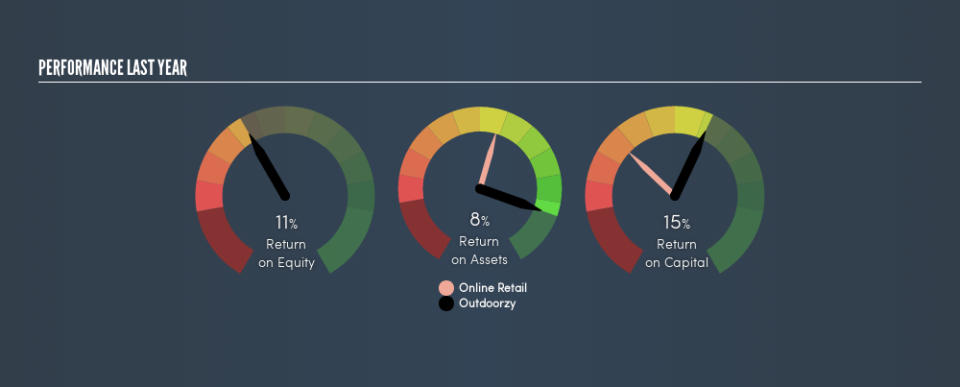Why Outdoorzy S.A.’s (WSE:OUT) Return On Capital Employed Is Impressive

Today we are going to look at Outdoorzy S.A. (WSE:OUT) to see whether it might be an attractive investment prospect. Specifically, we're going to calculate its Return On Capital Employed (ROCE), in the hopes of getting some insight into the business.
First of all, we'll work out how to calculate ROCE. Second, we'll look at its ROCE compared to similar companies. Finally, we'll look at how its current liabilities affect its ROCE.
Return On Capital Employed (ROCE): What is it?
ROCE measures the 'return' (pre-tax profit) a company generates from capital employed in its business. Generally speaking a higher ROCE is better. In brief, it is a useful tool, but it is not without drawbacks. Renowned investment researcher Michael Mauboussin has suggested that a high ROCE can indicate that 'one dollar invested in the company generates value of more than one dollar'.
So, How Do We Calculate ROCE?
The formula for calculating the return on capital employed is:
Return on Capital Employed = Earnings Before Interest and Tax (EBIT) ÷ (Total Assets - Current Liabilities)
Or for Outdoorzy:
0.15 = zł253k ÷ (zł2.6m - zł917k) (Based on the trailing twelve months to January 2019.)
Therefore, Outdoorzy has an ROCE of 15%.
Want to participate in a short research study? Help shape the future of investing tools and you could win a $250 gift card!
Check out our latest analysis for Outdoorzy
Is Outdoorzy's ROCE Good?
ROCE can be useful when making comparisons, such as between similar companies. Outdoorzy's ROCE appears to be substantially greater than the 12% average in the Online Retail industry. We consider this a positive sign, because it suggests it uses capital more efficiently than similar companies. Separate from Outdoorzy's performance relative to its industry, its ROCE in absolute terms looks satisfactory, and it may be worth researching in more depth.
As we can see, Outdoorzy currently has an ROCE of 15% compared to its ROCE 3 years ago, which was 6.4%. This makes us think the business might be improving.
Remember that this metric is backwards looking - it shows what has happened in the past, and does not accurately predict the future. ROCE can be deceptive for cyclical businesses, as returns can look incredible in boom times, and terribly low in downturns. ROCE is, after all, simply a snap shot of a single year. How cyclical is Outdoorzy? You can see for yourself by looking at this free graph of past earnings, revenue and cash flow.
Outdoorzy's Current Liabilities And Their Impact On Its ROCE
Short term (or current) liabilities, are things like supplier invoices, overdrafts, or tax bills that need to be paid within 12 months. Due to the way ROCE is calculated, a high level of current liabilities makes a company look as though it has less capital employed, and thus can (sometimes unfairly) boost the ROCE. To counter this, investors can check if a company has high current liabilities relative to total assets.
Outdoorzy has total liabilities of zł917k and total assets of zł2.6m. Therefore its current liabilities are equivalent to approximately 35% of its total assets. Outdoorzy has a middling amount of current liabilities, increasing its ROCE somewhat.
What We Can Learn From Outdoorzy's ROCE
Outdoorzy's ROCE does look good, but the level of current liabilities also contribute to that. Outdoorzy looks strong on this analysis, but there are plenty of other companies that could be a good opportunity . Here is a free list of companies growing earnings rapidly.
For those who like to find winning investments this free list of growing companies with recent insider purchasing, could be just the ticket.
We aim to bring you long-term focused research analysis driven by fundamental data. Note that our analysis may not factor in the latest price-sensitive company announcements or qualitative material.
If you spot an error that warrants correction, please contact the editor at editorial-team@simplywallst.com. This article by Simply Wall St is general in nature. It does not constitute a recommendation to buy or sell any stock, and does not take account of your objectives, or your financial situation. Simply Wall St has no position in the stocks mentioned. Thank you for reading.

